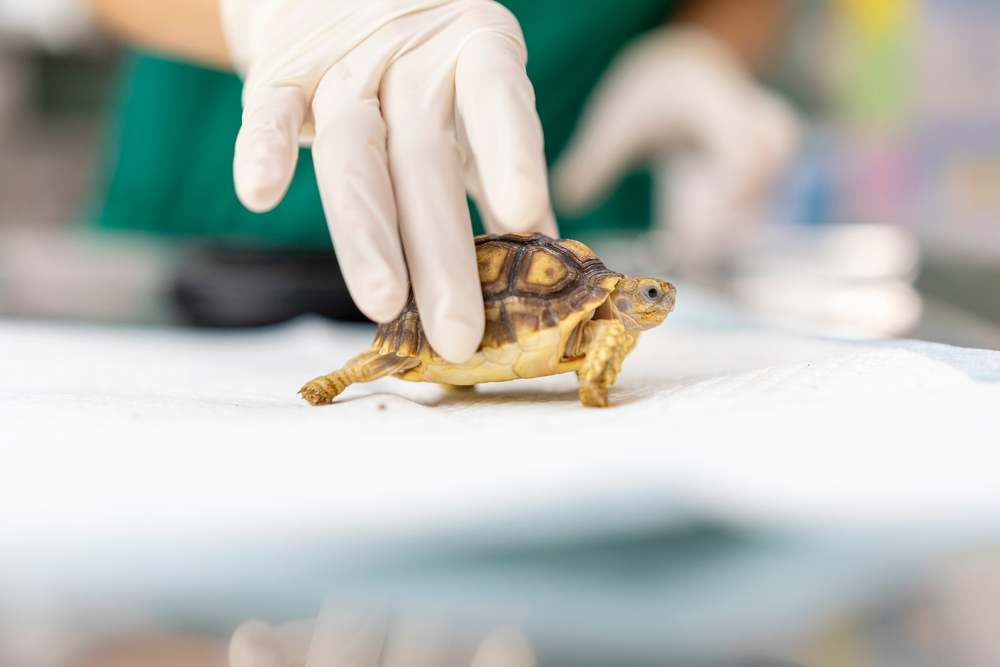By Dr Michaela Betts
Immediate Reptile First Aid – Traumatic Injuries & Thermal Burns
Traumatic injuries may involve the musculoskeletal and central nervous system of reptile patients. The patient should be assessed for any blood loss, and if there is ongoing active bleeding then suitable management to prevent further blood loss should be performed. This may be through applying suitable pressure to the area with sterile material or applying a temporary compression bandage to the area (though caution needs to be taken to not cut off the blood supply and cause circulation issues). For bleeding nails where continuous pressure does not resolve bleeding, styptic powder or, anecdotally, cornstarch may be applied to the nail tip to try to help with clotting.
Burns can range from very mild to life threatening in severity and are classified based on the depth of damaged tissue. A cold compress can be applied for 15-20 minutes to help reduce further burning and tissue swelling before transporting for veterinary assessment and stabilisation.
Although it may seem counterintuitive, where possible wounds and burns should not be cleaned before presenting to a veterinary professional. Whilst decontamination is important, bacterial and fungal cultures are often an important investigatory step to guide antimicrobial treatment and rigorous cleaning before the areas have been swabbed can affect these results. In the case of deep shell trauma in chelonian patients, there is also a risk of accidentally drowning the individual by flushing fluid and debris into the coelomic body cavity. However, moistened sterile bandage material may be placed over superficial injuries to protect exposed bone and/or tissue during transport. Suspected broken limbs should not be splinted and should only be bandaged when required to stop active bleeding.

Immediate Reptile First Aid – Cloacal Prolapse
Cloacal prolapse is a clinical sign of an underlying disease process or inappropriate husbandry and should be recognised as a symptom rather than a singular disease itself. The phallus, hemipenes, oviduct, bladder, colon, and cloaca have all been reported as prolapsing through the vent. This is a true emergency and veterinary attention needs to be sought as soon as possible to appropriately identify the prolapsed organ and pursue appropriate interventions.
Keeping the prolapsed tissue viable is of critical importance for promoting a successful recovery. If the prolapsed tissue is not appropriately protected and any circulation issues corrected, necrosis of the tissue can quickly follow. The affected reptile should immediately be moved onto a clean substrate such as kitchen towel to reduce risk of contamination and injury of the affected tissue. A water-based lubricant can then be gently and generously applied to cover as much of the tissue as possible. Cleaning of the prolapse to remove gross contamination can be performed with warm water prior to application of the lubricant, but if material is adhered to the surface this can be difficult to remove without causing damage to the tissue and time may be better spent transporting the reptile for medical assessment.
Immediate Reptile First Aid – Hypothermia & Hyperthermia
Reptiles are ectotherms and so rely on external sources for body heat. Inappropriate hibernation or set-up temperatures, or accidental escapes into cold environments, can all result in hypothermia. Hypothermic reptiles are often lethargic, may have reduced reflexes and neurological signs, and can develop ocular damage if frost bite has occurred.
In cases of suspected hypothermia, the reptile should be slowly warmed to their preferred optimum temperature zone over the course of several hours: starting with slow warming to room temperature and then adding in additional heating. Caution should be taken to ensure reptiles are mobile enough to move towards or away from added heat sources to avoid the risk of hyperthermia.
Conversely, inappropriately high temperatures, such as through equipment fault or overexposure to sunlight, can quickly lead to hyperthermia. Reptiles possess very limited mechanisms to compensate for increases in body temperature and so quick cooling is warranted. This is typically best achieved by bathing the patient in a lukewarm bath or by sprinkling them with lukewarm water. They should then be kept and transported at the lower end of their preferred optimum temperature zone until veterinary assessment.
Reptile First Aid Kits
Always remember to keep a first aid kit available in case of emergencies. For more information on how to build, store and maintain an effective first aid kit, click here.
